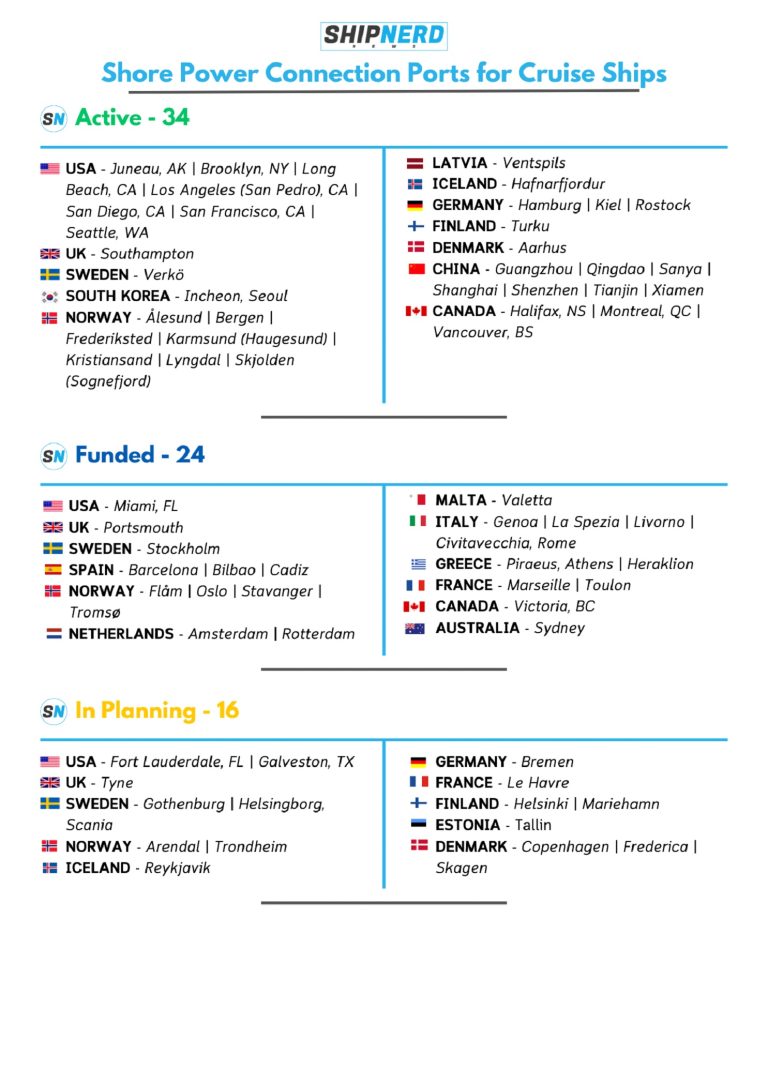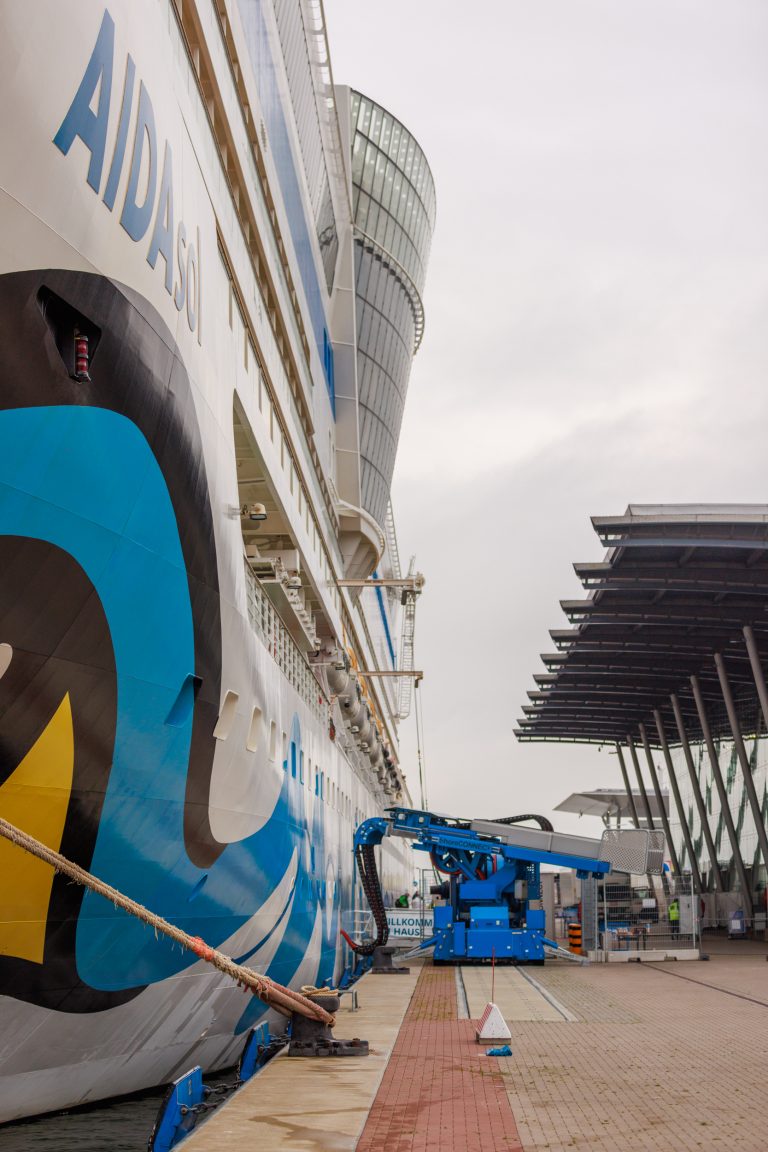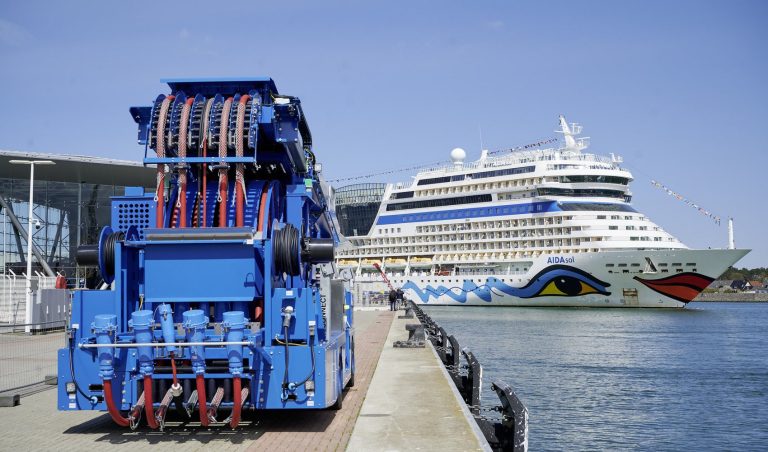Advancing Sustainability: Electrification of Ports
What is a shore power connection? Alexandros Lampoglou and Ilias Bougas from Ship Nerd News are getting you up to speed with the concept of Onshore Power Supply that reduces emissions and eliminates the noise levels at port.
Onshore Power Supply (OPS), also commonly referred to as Shore Power, Shoreside Electricity (SSE), Alternative Maritime Power (AMP), High-Voltage Shore Connection (HSCV), or Cold Ironing, represents an alternative power option for ships at berth which, by allowing onboard generators to be stopped, reduces the emissions. The primary objective for OPS, the Shore-Side Electricity option with more applications, until very recently, has been focused on the improvement of port local air quality through the reduction of ship-sourced pollutants such as Nitrogen Oxides (NOx), Sulphur Oxides (SOx), Particulate Matter (PM), or other substances associated to onboard combustions processes. The reduction of CO2 emitted from ships at berth would also be a relevant result, particularly if the electricity mix supplied is mostly sourced from blue/green electrical production sources (biomass, hydro, or renewables).
As part of the EU’s Fit for 55 initiative, which aims at reducing pollution and achieving net-zero carbon emissions, every major port in the European Union is mandated to implement shoreside electricity infrastructure by 2030. This infrastructure will enable ships to connect and minimize emissions while at port. In alignment with this directive, cruise lines associated with CLIA (Cruise Lines International Association) are devoted to their commitment, to utilize shoreside electricity when available. Collaborative efforts with ports are underway to facilitate the implementation of this commitment. Hence, there is a proactive push for prioritizing investments in shore power supply facilities at cruise berths in ports where cruise ships are scheduled to dock. To support this transition, cruise lines are actively investing in retrofitting ships and equipping them with the capability to connect to shoreside electricity. Over 210 ships within the CLIA fleet are expected to possess shoreside power capability by the year 2028. Furthermore, ongoing retrofitting efforts will extend this capability to additional ships, encompassing 72% of the fleet and representing 74% of global passenger capacity. This collective industry commitment underscores a concerted effort toward sustainable and emission-reducing practices within the cruise sector.
Electrification of Ports
Shoreside electricity options
On-shore power supply
The adoption of Onshore Power Supply (OPS) technology plays a pivotal role in mitigating ship emissions at berth. This progress aligns with the increasing availability of OPS, as part of ports sustainability initiatives. The supply of high-voltage electricity is a key catalyst for OPS of higher power-demanding ships. Implementing OPS projects requires the collaboration of various stakeholders, emphasizing the delicate nature of this sustainable solution.
Since the automation of OPS system architecture is on the rise, it is contributing to more efficient and streamlined operations. As an outcome of these advancements, more ports now provide OPS services, offering ships the means to reduce emissions while docked. This shift has far-reaching benefits, positively impacting local air quality, reducing greenhouse gas emissions, and mitigating noise pollution. Recognizing the diverse operating profiles of ships at berth, there is an increasing focus on the importance of high-voltage supply (>1 kV AC) for more efficient connections.
Furthermore, addressing aspects such as matching AC frequency (50/60 Hz) becomes crucial, particularly for transoceanic vessels. The attainment of standardization, exemplified by the comprehensive IEC/IEEE 8005 series, adds a layer of consistency to OPS implementation. Conclusively, the International Maritime Organization (IMO) has finalized Interim Guidelines for Safe OPS operation, marking a significant step toward ensuring the safety and efficacy of OPS technology in the maritime industry.
Electrification of Ports
Shoreside battery charging
The surge in electric and hybrid ships has propelled advancements in shore-side battery charging, evolving in tandem with the increasing numbers of these vessels. A vital aspect of this progress is the adoption of charging from port-side infrastructure, facilitated through onshore transformers. The growing fleet of electric and hybrid ships has led to the creation of automated shore-side battery charging options, often intricately connected with dedicated mooring systems. A notable benefit of this development is the conservation of significant onboard space on the receiving ship, achieved by incorporating shore-side transformers. Specifications for shore-side battery charging typically include multi-megawatt-hour (MWh) chargers, emphasizing the need for fast charging capabilities during brief berthing periods.
This evolution in the transformative shift in the maritime industry underscores the commitment to finding cleaner and more efficient energy solutions that can contribute to the reduction of greenhouse gas emissions in the near future.
Battery swapping
Battery swapping can be considered a promising solution for electric and plug-in vessels, offering the potential to significantly reduce turnaround times at berths by eliminating the need to “wait-to-charge”. The success of this approach hinges on two crucial factors: modularity and standardization. By embracing these principles, battery swapping not only enhances flexibility but also reduces charging periods during berths, leading to operational gains, especially in waterborne trade with fixed routes. The industry’s high demand for standardized solutions reflects a collective effort to mitigate the risks associated with multiple proprietary approaches.
To support the widespread adoption of battery swapping, it is imperative to design ship-shore interface infrastructure that ensures swift and safe handling of battery module units, further contributing to the efficiency and reliability of this innovative technology.
AIDAmar_&_AIDAsol
Current Status
As sustainability in the cruise industry has been a top priority in recent years, cruise lines have been proactive in the adoption of new standards. Over the past years, cruise leaders have been increasingly focusing on reducing and transitioning their fleets’ consumption to reach the lowest levels possible. As a result, cruise lines are working to get a greener way to operate by using alternative power such as LSFO, LNG, MGO, or shore power in port.
On the port side, as there is also an increased awareness of the actions for improving sustainability, one of the initiatives is to provide shore power connections. Even though that is not an infant concept in the cargo and ferries sector, it requires an investment for Cruise Ports as the equipment and installation involved is more complex than for cargo ports.
In general, FuelEU Maritime sets well-to-wake greenhouse gas (GHG) emission intensity requirements on the energy used on board ships trading in the EU from 2025. Furthermore, it mandates the use of shore power for container and cruise ships in certain EU ports from 2030.
From 2030, passenger ships are required to connect to shore power when at berth for more than two hours in a Trans-European Transport Network (TEN-T) port. From 2035, the requirement will apply to all ports where shore power is available. Currently, Northern America leads the industry for cruise ship shore power supply. One of the factors is that ports are bigger and accommodate larger cruise ships on a regular basis. These larger vessels are newer and hence equipped for cold ironing, therefore the demand in this area is higher than in Europe where these ships do not call frequently.
A summary of the identified ports equipped with shore power for cruise ships is presented in the following tables.
Elecrification of Ports
Thoughts from Ship Nerd
While we mentioned the current status and available infrastructure on the shore connection, there is no information on the number of, active-funded-in planning, ports with cold ironing that actually using green electricity. Green electricity is produced from renewable sources such as wind, solar and hydro and comes with a much lower environmental impact than fossil fuels like coal and gas. In view of the above and considering that there should not be many, if any at all, green ports, it is challenging to quantify the real benefit. In the short term, it is not so important where the power comes from, even if it is a coal power station. The industry shall invest to the idea that the infrastructure will be ready in short term, hence allow the port and ships to transition when green power is available. Everything would take significantly longer in the event that no ports or ships prepared for shore power until the green electricity was available.
Future Developments
In addition to the Onshore Power Supply (OPS), the EMSA Guidance on Ship Shore Electricity (SSE) also encompasses Shore-side Battery Charging (SBC) and Shore-side Power Banks (SPB) as mentioned above. These alternatives have considerable growth potential in the future with some service applications already in formation. Even though the current experience and knowledge of these SSE alternatives is limited, it is necessary to emphasize from an early stage the associated risks. More in-depth consideration should be focused on the battery charging and liquid electrolyte battery systems, especially on the use of lithium-ion technology.
AIDA_Sol
Conclusion
In summary, the implementation of Onshore Power Supply (OPS), can be considered as a considerable measure for the reduction of local emissions and minimizing the level of noise at ports, thereby enhancing the environmental impact of the cruise ships while at port. For facilitating the adoption of OPS, it is important to be recognized as a priority business case by the different countries where public funds would be essential, especially at cruise terminals. It should be part of the infrastructure investments in their broader decarbonization strategies.
A pivotal factor in the transition away from fossil fuels during berths would be competitive electricity pricing. Financial incentives, such as economical charging tariffs, elimination, or reduction of the taxes on electricity, and the avoidance of front-end loaded cost recovery regimes on infrastructure could play a crucial role in this transition. Internationally agreed standards should come to a place where the technical requirements would be reasonable enough for the ports to be able to comply with and guarantee compatible and secure connections between ports and vessels worldwide.
Lastly, further studies need to be addressed on whether ports mandated to have cold ironing capabilities will be able to possess the necessary energy surplus requirement to be able to support the substantial power requirements of any type of ship.
Elecrification of Ports
About Ship Nerd News
Ship Nerd is a leading news and publication website focused on providing the latest technical updates and insights about the shipping industry. Covering maritime, engineering, and automation news, offering expert analysis, in-depth reviews, and thought-provoking opinion pieces for industry professionals and enthusiasts alike. The platform is trusted by experienced and knowledgeable stakeholders, including engineers, technical managers, and executives, who rely on it to stay up-to-date with the latest technological advancements, industry trends, and best practices. With an organic global reach and a targeted audience (US, EU & Asia), we have been successful in connecting maritime industry professionals widely.
From breakthrough marine technology to breaking shipping news, Ship Nerd delivers the most exciting and intriguing stories in the maritime industry.
Don’t miss more updates, news and reviews on the world of cruises on Cruising Journal.






